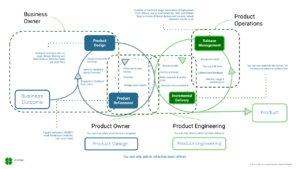When we talk about Portfolio Design, we’re not just talking about managing a backlog or keeping a list of projects. We’re talking about the intentional structuring of work across an organization to maximize responsiveness, strategic alignment, and effective delivery through the right portfolio management tools. In essence, we’re designing the whole system of work.
This series has been diving into the key elements that make that possible, and this post is focused on the sixth one: using the right portfolio management tools.
Let’s be clear—tools don’t solve problems by themselves. Slapping on a new platform or dashboard won’t fix structural issues, bad workflows, or a lack of clarity in your portfolio. But—and it’s a big but—when chosen thoughtfully and integrated intentionally, the right tools can make a huge difference. They help reduce friction, surface issues early, and create the transparency you need to adapt and lead effectively.
When Portfolio Tools Create Problems
We’ve all seen it. An organization with 17 different tools doing overlapping things, none of them connected. Or a team that spends more time updating systems than delivering value. Even worse, leadership dashboards that show everything is green… until it’s not.
However, when tools are wrong for the job, poorly integrated, or just too many, they create fragmentation. That fragmentation leads to confusion, duplication, unnecessary costs, and ultimately, dysfunction. It makes things harder when the goal is to make them easier.
Here are three very real challenges this causes in organizations:
1. Delivery Expenses Go Through the Roof
Sky-high delivery costs are often a sign of inefficiency in the delivery system. We see this in coordination overhead, rework, misaligned priorities, and bottlenecks. A big contributing factor? Tools that don’t help (or actively get in the way). Instead of helping reduce unnecessary work or provide signals to adjust course, they become part of the overhead.
And let’s not forget about too much work in progress (WIP). Moreover, when tools don’t help visualize or manage WIP, teams get spread thin, deadlines slip, and costs balloon.
2. Invisible Progress
In environments that value continuous delivery and fast feedback, lack of visibility is deadly. Leaders can’t make confident decisions. Teams lose alignment. Progress becomes anecdotal, not data-driven.
If your tools don’t provide a real-time, high-fidelity view of what’s happening, you’re flying blind. And without instruments, you can’t steer. You miss opportunities to course-correct, allocate resources, or adapt strategy in real-time.
3. Spinning Wheels
We often work with teams that are incredibly busy—but feel like they’re going nowhere. That’s often a sign of inefficient structures: unclear value streams, overloaded cognitive demand, ambiguous team boundaries, and messy dependencies.
Furthermore, the right tools should make this clearer—not add to the fog. If they’re not showing you where flow is blocked or where responsibilities overlap, they’re part of the problem.
Strategic Portfolio Tool Selection
So how do we fix this? Not by throwing tools at the problem. We fix it by approaching tooling as part of the Portfolio Design process itself. Effective portfolio management tools should be selected based on your specific organizational needs.
Good Portfolio Design includes tool strategy from the start. It’s not an afterthought—it’s a foundational choice that supports everything else.
Your tools should:
- Fit your workflow and org design (not the other way around)
- Empower teams by making work easier to see and manage
- Clarify complexity, not add to it
How Portfolio Management Tools Drive Success
Let’s look at how good portfolio management tools—aligned with intentional design—actually supports effective portfolio management.
1. Portfolio Management Tools for Enhanced Visibility
The right tools help everyone see what’s going on. This is more than a progress bar—it’s about real-time, contextual insight into work in progress, outcomes, and flow.
You get a “dashboard of instruments”—not just for leaders, but for teams too. This enables proactive conversations, better planning, and informed decisions. You’re no longer flying blind.
2. Collaboration Tools Supporting Portfolio Flow
Integrated tools reduce friction between teams. They create shared context, streamline communication, and visualize how value flows through the system.
Done well, your tooling helps teams spot:
- Bottlenecks
- Hand-offs that don’t add value
- Loops and rework that should be eliminated
This is what we mean when we talk about enabling flow—the unblocked, continuous movement of valuable work from idea to outcome.
3. Portfolio Tools for Better Prioritization
Prioritization frameworks are essential—but even the best frameworks fail without tools that support them. Additionally, good tools make WIP visible. They let you see when demand outstrips capacity, when teams are over-committed, and when you need to say “not now.”
They help you limit WIP, which is one of the fastest ways to improve speed, quality, and outcomes.
4. How Portfolio Tools Reduce Delivery Costs
Let’s bring it full circle. When tools improve visibility, support flow, and help you manage WIP and dependencies, costs go down.
Why? Because you:
- Do less rework
- Catch issues earlier
- Reduce wait times and handoffs
- Use your people more effectively
It’s not about tools being cheap—it’s about them helping you deliver better.
5. Aligning Portfolio Management Tools with Organization Design
Finally—and this is important—tools should support how your organization works, not force you to work a certain way just to fit the tool.
If your tool can’t handle cross-functional teams, strategic initiatives, or dual-track delivery—it’s not the right tool. If it silos information or creates “islands of data,” it’s working against you.
The best tools:
- Reflect your designed structure
- Empower decentralized teams
- Provide a shared source of truth
Final Thoughts
Choosing the right portfolio management tools is a strategic design decision. It’s not about features. Rather, it’s not about what’s trending. The focus should be on what helps you see clearly, collaborate effectively, and deliver consistently.
Tools don’t fix portfolio problems. But the right ones, used intentionally, help you:
- Align with strategy
- Manage complexity
- Reduce waste
- Enable adaptability
In short, they help you run your portfolio like a well-oiled system, not a chaotic mess.
In the final post of this series, we’ll take a step back and look at how to assess where you are and how to grow your portfolio management maturity over time. Stay tuned—because the journey doesn’t stop here.




